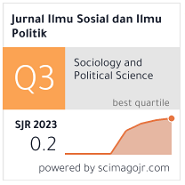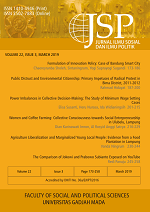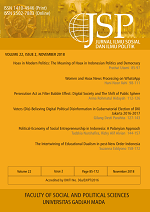“It’s Okay to be Slow:” Witnessing the Articulation of Connected Practices by Creative Collectives in Indonesia and Malaysia
Zaki Habibi(1*)
(1) Department of Communications, Universitas Islam Indonesia, Yogyakarta, Indonesia
(*) Corresponding Author
Abstract
This article focuses on the everyday responses of the local creatives in dealing with the problematic single narrative of creative cities. Aiming to understand the everyday creative and media practices of individuals in the creative collectives that are situated in emerging creative cities in Southeast Asia, the research specifically addresses key contemporary debates within the field of urban media and communication studies. The article gives priority to the voices of the city dwellers from a bottom-up approach, looking at the material and embodied practices in their everyday life. Empirically, this article seeks the alternative voices raised by the members of selected creative collectives - four collectives in Bandung, Indonesia, and four others in George Town, Malaysia - in articulating the meaning of creativity, the media practices involved within, and the organic ways of organizing urban collectives. Drawing insights from the notion of articulation and media practice, and by employing both ethnographic and visual methodology approaches, in particular the use of the photo-documentation method, there are three key thematic findings elaborated here. These themes are (1) social settings in media-related practices, (2) material objects and sensitive affection, and (3) the labor of love. The ways in which these are discussed, using a combination of ethnographic vignettes and photo collages, foreground the importance of cultural identity articulation practiced by the creative collectives in both cities. Thus, the interlinkage between mediated experiences, spatial practices, and visual contexts is also a key significant aspect in the analysis of these bottom-up, organic urban creativities.
Keywords
Full Text:
PDFReferences
Aiello, G., & Tosoni, S. (2016). Urban communication | Going about the city: Methods and methodologies for urban communication research — introduction. International Journal of Communication, 10, 1252-1262. https://ijoc.org/index.php/ijoc/article/view/5416
BEKRAF. (2018). World conference on creative economy 2018 - program objectives. WCCE; BEKRAF (Badan Ekonomi Kreatif Indonesia / The Indonesian Creative Economy Agency) Retrieved from http://developing8. org/wp-content/uploads/2018/05/preview-Programe- objective-book.pdf
Bengtsson, S. (2014). Faraway, so close! Proximity and distance in ethnography online. Media, Culture & Society, 36(6), 862-877. https://doi.org/10.1177/0163443714531195
British-Council-Indonesia. (n.d.). Creative economy. https://www.britishcouncil.id/ en/programmes/arts/creative-economy
Caldwell, G. A., Smith, C. H., & Clift, E. M. (Eds.). (2016). Digital Futures & The City of Today: New Technologies and Physical Spaces. Intellect.
Clarke, J. (2015). Stuart Hall and the theory and practice of articulation. Discourse: Studies in the Cultural Politics of Education, 36(2), 275-286. https://doi.org/10.1080/01596306.2015.1013247
Florida, R. (2012). The rise of the creative class: Revisited. Basic Books.
Gauntlett, D. (2018). Making is connecting: The social power of creativity, from craft and knitting to digital everything (2 ed.). Polity Press.
Georgiou, M. (2013). Media and the cty: Cosmopolitanism and difference. Polity Press.
Gray, A. (2003). Research practice for cultural studies. SAGE Publications.
Gu, X., Lim, M. K., & O'Connor, J. (2020). Re-imagining creative cities in twenty- first century Asia. Palgrave Macmillan (Springer International Publishing).
Hall, S. (1992). The question of cultural identity. In S. Hall, D. Held, & T. McGrew (Eds.), Modernity and its futures: Understanding modern societies (pp. 273-325). Polity Press; Blackwell Publisher Ltd.; Open University.
Hall, S. (2019a). Race, articulation, and societies structured in dominance. In D. Morley (Ed.), Essential essays, volume 1: Foundations of cultural studies (pp. 172-221). Duke Univ ersity Press. (Reprinted from Sociological theories: race and colonialism, pp. 305-345, by M. O'Callaghan, Ed., 1980, UNESCO)
Hall, S. (2019b). On postmodernism and articulation: An Interview with Stuart Hall by Larry Grossberg and others. In D. Morley (Ed.), Essential essays, volume 1: Foundations of cultural studies (pp. 223-255). Duke University Press. (Reprinted from “On postmodernism and articulation: An interview with Stuart Hall,” 1986, Journal of Communication Inquiry, 10(2), 45-60, https://doi.org/10.1177/019685998601000204)
Harper, D. (2003). Framing photographic ethnography: A case study. Ethnography, 4(2), 241-266. https://doi. org/10.1177/14661381030042005
Heng, T. (2017). Visual methods in the field: Photography for the social sciences . Routledge.
Highmore, B. (2005). Cityscapes: Cultural readings in the material and symbolic city. Palgrave Macmillan.
Hobart, M. (2014a). Introduction: Rethinking Asian media and film. Asian Journal of Social Science, 41(5), 425-436. https://doi. org/10.1163/15685314-12341312
Hobart, M. (2014b). When is Indonesia? Asian Journal of Social Science, 41(5), 510-529. https://doi.org/10.1163/15685314-12341315
Knox, P. (2022). The creative city. In P. Knox (Ed.), Atlas of cities (pp. 194-209). Princeton University Press. https://doi. org/10.1515/9781400851942-014
Krajina, Z., & Stevenson, D. (Eds.). (2020). The Routledge companion to urban media and communication. Routledge.
Löfgren, O. (2007). First we take Manhattan, then we take Berlin…. In G. Marling & M. Zerlang (Eds.), Fun city (pp. 74- 98). Arkitektens Forlag (The Danish Architectural Press).
Löfgren, O. (2014). Catwalking the city. In P. O. Berg & E. Björner (Eds.), Branding Chinese mega-cities: Policies, practices and positioning (pp. 195-206). Edward Elgar.
Löfgren, O. (2016). Emotional baggage: Unpacking the suitcase. In M. P. Frykman & J. Frykman (Eds.), Sensitive objects: Affect and material culture (pp. 125-151). Nordic Academic Press. https://doi.org/10.21525/ kriterium.6.f
Mattern, S. (2015). Deep mapping the media city. University of Minnesota Press.
McGuigan, J. (2009). Cool capitalism. Pluto Press.
Miller, D., Costa, E., Haynes, N., McDonald, T., Nicolescu, R., Sinanan, J., Spyer, J., Venkatraman, S., & Wang, X. (2016). How the world changed social media. UCL Press.
Pink, S., Horst, H., Postill, J., Hjorth, L., Lewis, T., & Tacchi, J. (2016). Digital ethnography: Principles and practice. SAGE.
Postill, J. (2010). Introduction: Theorising media and practice. In J. Postill & B. Bräuchler (Eds.), Theorising media and practice (pp. 1-32). Berghahn Books. http://www.jstor. org/stable/j.ctt9qd3vc.5
Ridell, S., & Zeller, F. (2013). Mediated urbanism: Navigating an interdisciplinary terrain. International Communication Gazette, 75(5-6), 437-451. https://doi. org/10.1177/1748048513491891
Rose, G. (2016). Visual methodologies: An introduction to researching with visual materials (4 ed.). SAGE Publications Ltd.
Santos, J. P. (2020). ‘Crisis of values’ in rhetorical architecture: Creative cities discourse and the urban landscapes of the Philippines. In X. Gu, M. K. Lim, & J. O'Connor (Eds.), Re-imagining creative cities in twenty- first century Asia (pp. 77-93). Palgrave Macmillan (Springer International Publishing). https://doi.org/10.1007/978-3-030-46291-8_6
Shin, H. (2020). From foreign community to creative town? Creativity and contestation in Itaewon, Seoul. In X. Gu, M. K. Lim, & J. O'Connor (Eds.), Re-imagining creative cities in twenty-first century Asia (pp. 95-111). Palgrave Macmillan (Springer International Publishing). https://doi. org/10.1007/978-3-030-46291-8_7
Sudrajat, D. C., & Siregar, F. (2017). Enabling spaces: Mapping creative hubs in Indonesia. https://cipg.or.id/en/publication/creative- hubs-in-indonesia-1
UN-DESA. (2018). World urbanization prospects: The 2018 revision. https://population. un.org/wup
UNESCO. (2015). Bandung – Creative City of Design, UNESCO Creative Cities Network. http://en.unesco.org/creative-cities/bandung
Wu, J.-Y. (2020). A humble creative city: Tainan City as a case study of culture-led and community-supported transformation of a historical city. In X. Gu, M. K. Lim, & J. O'Connor (Eds.), Re-imagining creative cities in twenty-first century Asia (pp. 129-142). Palgrave Macmillan (Springer International Publishing). https://doi. org/10.1007/978-3-030-46291-8_9
Article Metrics
Refbacks
- There are currently no refbacks.
Copyright (c) 2022 Jurnal Ilmu Sosial dan Ilmu Politik

This work is licensed under a Creative Commons Attribution-NonCommercial-NoDerivatives 4.0 International License.






















